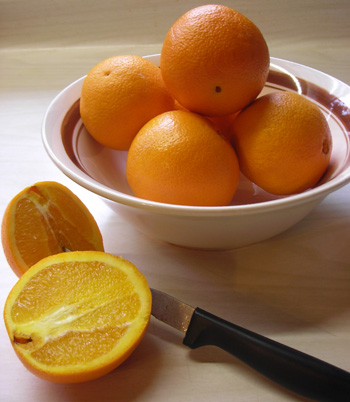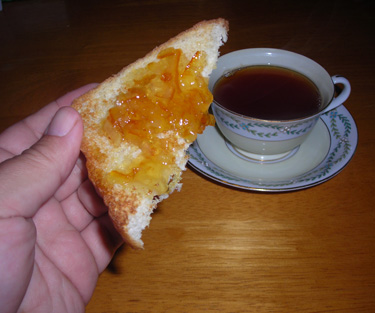















Soul Food
The Versatile Orange
Now universally available and accessible to all consumers, oranges were once a holiday treat for working class families in the American South, particularly during the Great Depression and the war years. My parents recall the excitement of receiving a brown paper sack containing two or three oranges, an apple or two, some English walnuts and pecans and a few peppermint candies on Christmas Day. Today, shoppers can visit the supermarket and find a produce counter laden with an array of orange varieties and a dairy case filled with juices. With the availability of everything from jars of orange blossom honey and marmalade to orange-flavored desserts and canned mandarin oranges, it is difficult to imagine a time when oranges and orange-based products were not abundant and affordable.
Asian in origin and first cultivated in China, the orange has certainly demonstrated its versatility. Grown mostly for juice production, oranges are also a source of pectin, a gelling agent used in everything from jellies to fiber supplements. Oranges are even important in the making of household cleaning products and perfumes. Often overlooked is the role oranges have come to play in the gastronomy of various cultures throughout the world. Beyond the Far East, oranges are grown around the globe, and are of agricultural significance in the United States (especially in Florida), Brazil, Australia, South Africa and various countries throughout the Mediterranean region, including those of Europe, Northern Africa and the Near East.

In the Arab world, orange blossom water is used to prepare scrumptious desserts and baked goods. Italians and their neighbors grow Bergamot oranges (Citrus x bergamia), which give a distinctive flavor to Earl Grey tea, the favorite of Her Majesty Queen Elizabeth II and millions of tea lovers throughout the United Kingdom and elsewhere. In Sevilla, Spain and other Mediterranean locales, bitter oranges (Citrus x aurantium) are grown to produce the marmalade that is so popular among the British. And, even in the culturally and ethnically diverse United States, it is not far-fetched to find orange slice cake in a hole-in-the-wall soul food eatery just blocks from a Chinese take-out where immigrants prepare one's favorite orange-infused chicken dish.
In the context of southern cuisine, oranges have long been a popular fruit or important ingredient as evidenced by the many recipes contained in century-old cookbooks. While some of the outdated terminology and esoteric notions merit a little translation and improvisation in an age of electric ranges, food processors and pressure cookers, these recipes can prove invaluable and insightful, all the while evoking a sense of nostalgia and a longing for simpler times. One particularly delightful old book, Housekeeping in Old Virginia, was first published in 1879 by John P. Morton and Company of Louisville, Kentucky. Its content, including a number of orange-based dishes, is now well within the public domain. Still quite popular, the book has been reprinted on numerous occasions during the last century, and the following recipes have been included here to inspire readers to explore the various uses for which oranges are suited:
In the context of southern cuisine, oranges have long been a popular fruit or important ingredient as evidenced by the many recipes contained in century-old cookbooks. While some of the outdated terminology and esoteric notions merit a little translation and improvisation in an age of electric ranges, food processors and pressure cookers, these recipes can prove invaluable and insightful, all the while evoking a sense of nostalgia and a longing for simpler times. One particularly delightful old book, Housekeeping in Old Virginia, was first published in 1879 by John P. Morton and Company of Louisville, Kentucky. Its content, including a number of orange-based dishes, is now well within the public domain. Still quite popular, the book has been reprinted on numerous occasions during the last century, and the following recipes have been included here to inspire readers to explore the various uses for which oranges are suited:

Orange Conserves
Cut the peel in long, thin strips, and stew in water till all bitterness is extracted. Drain off this water and stew again in a thick syrup, allowing one pound sugar to each pound peel. Put away in a cool place for flavoring puddings, pies, etc.
Orange Pie
Pulp and juice of two oranges, a little of the grated peel, the yolks of three eggs, one cupful sugar, one cupful milk. Stir the yolks with the sugar, then a tablespoonful of butter, then the juice, lastly the milk. Bake in a dish. After the pie has cooled, spread on it the white of the three eggs, stiffly frothed and sweetened. Then set it again on the fire to brown slightly. -- Mrs. McG.
Orange Pudding
Peel and cut five good oranges into thin slices, taking out the seed. Pour over them a coffee cup of white sugar. Let a pint of milk get boiling hot by setting it in some boiling water. Add yolks of three eggs well beaten, one tablespoonful corn starch, made smooth with a little milk. Stir all the time, and as soon as thickened, pour over the fruit. Beat the whites to a stiff froth, adding a tablespoonful of sugar, spread over the top. Set it in the oven a few minutes to harden. Serve either hot or cold. -- Mrs. E.P. Goggin, Lynchburg
Cut the peel in long, thin strips, and stew in water till all bitterness is extracted. Drain off this water and stew again in a thick syrup, allowing one pound sugar to each pound peel. Put away in a cool place for flavoring puddings, pies, etc.
Orange Pie
Pulp and juice of two oranges, a little of the grated peel, the yolks of three eggs, one cupful sugar, one cupful milk. Stir the yolks with the sugar, then a tablespoonful of butter, then the juice, lastly the milk. Bake in a dish. After the pie has cooled, spread on it the white of the three eggs, stiffly frothed and sweetened. Then set it again on the fire to brown slightly. -- Mrs. McG.
Orange Pudding
Peel and cut five good oranges into thin slices, taking out the seed. Pour over them a coffee cup of white sugar. Let a pint of milk get boiling hot by setting it in some boiling water. Add yolks of three eggs well beaten, one tablespoonful corn starch, made smooth with a little milk. Stir all the time, and as soon as thickened, pour over the fruit. Beat the whites to a stiff froth, adding a tablespoonful of sugar, spread over the top. Set it in the oven a few minutes to harden. Serve either hot or cold. -- Mrs. E.P. Goggin, Lynchburg
Toast with a generous spread of orange marmalade, accompanied by a good cup of English breakfast tea, is a tasty way to begin the day. Bitter oranges (Citrus x aurantium) grown in Sevilla, Spain and elsewhere throughout the Mediterranean region are used to produce the marmalade that is so popular in England. In the American South, gardeners can grow the cold hardy Poncirus trifoliata 'Flying Dragon' to produce fruits that are also suited for making marmalade.
Orange Marmalade
The day before making, peel one dozen oranges (no matter how sour and indifferent). Throw the peel in a bucket of water, take out the seed, cut up the pulp fine with a pair of old scissors. Then take the peel, cut it in thin strips and throw it into fresh water. Pare and slice pippins (or any other nice apple). Weigh six pounds of them, stew with a little water till perfectly done, and set away. Next day, run this pulp through a colander into a preserving kettle. Add six pounds sugar and boil slowly, constantly scraping from the bottom.
Take the orange peel (which should have been left in soak all night), boil till perfectly soft and free from bitterness, changing the water three times while boiling. In another preserving kettle, simmer this with the orange pulp and two pounds sugar. When both are nearly done, turn the oranges into the apples and cook them very thick. Cool in a bowl, and then put in a glass jar with a screw top. -- Mrs. Samuel Tyree, Lynchburg
The day before making, peel one dozen oranges (no matter how sour and indifferent). Throw the peel in a bucket of water, take out the seed, cut up the pulp fine with a pair of old scissors. Then take the peel, cut it in thin strips and throw it into fresh water. Pare and slice pippins (or any other nice apple). Weigh six pounds of them, stew with a little water till perfectly done, and set away. Next day, run this pulp through a colander into a preserving kettle. Add six pounds sugar and boil slowly, constantly scraping from the bottom.
Take the orange peel (which should have been left in soak all night), boil till perfectly soft and free from bitterness, changing the water three times while boiling. In another preserving kettle, simmer this with the orange pulp and two pounds sugar. When both are nearly done, turn the oranges into the apples and cook them very thick. Cool in a bowl, and then put in a glass jar with a screw top. -- Mrs. Samuel Tyree, Lynchburg
BIBLIOGRAPHY
Marion Cabell Tyree (ed.), Housekeeping in Old Virginia (Louisville: John P. Morton and Company, 1879).
Le Cordon Bleu Cuisine Foundations (Clifton Park, New York: Cengage Learning, Inc., 2011).
Author: Greg Freeman. Published October 7, 2012.
Marion Cabell Tyree (ed.), Housekeeping in Old Virginia (Louisville: John P. Morton and Company, 1879).
Le Cordon Bleu Cuisine Foundations (Clifton Park, New York: Cengage Learning, Inc., 2011).
Author: Greg Freeman. Published October 7, 2012.
Copyright
Southern Edition
All Rights Reserved
Southern Edition
All Rights Reserved
All materials contained on this site, including text and images, are protected by copyright laws and may not be reproduced without prior written permission from the publisher. Where applicable, use of some items contained on this site may require permission from other copyright owners.
Fair Use of text from SouthernEdition.com is permitted to the extent allowed by copyright law. Proper citation is requested. Please use this guide when citing a Southern Edition article.
Contact Greg Freeman or SouthernEdition.comFair Use of text from SouthernEdition.com is permitted to the extent allowed by copyright law. Proper citation is requested. Please use this guide when citing a Southern Edition article.